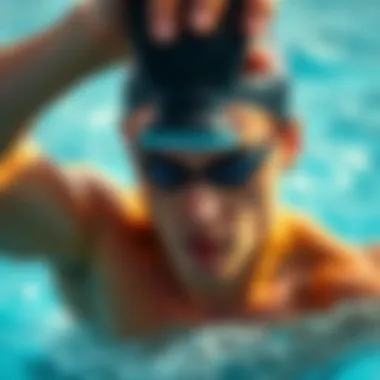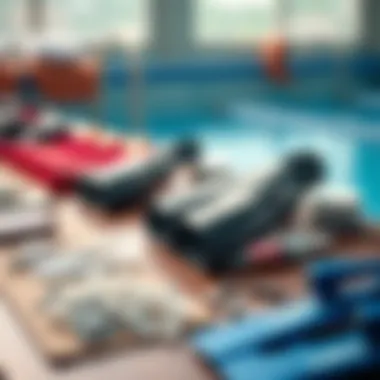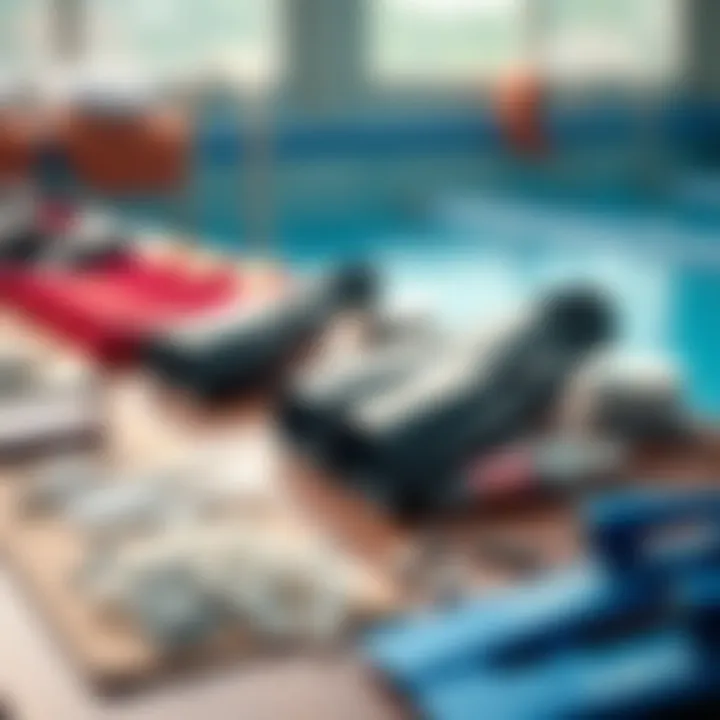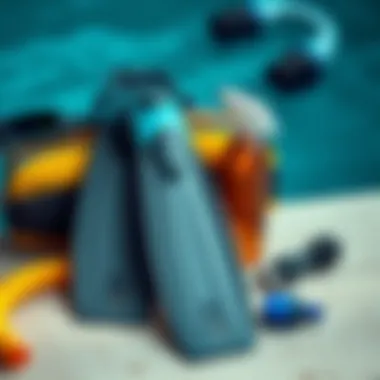Men's Swimming Flippers: A Thorough Guide


Intro
Swimming is more than just a leisurely activity; it’s an art form that combines technique, strength, and efficiency. Within this realm, men’s swimming flippers stand out as a pivotal tool for enhancing performance in the water. These accessories, often overlooked in casual discussions about swim gear, can dramatically affect one’s efficiency and comfort during swimming.
Understanding the different types of flippers available, the materials they are crafted from, and how they can elevate one’s swimming technique is essential for anyone serious about improving their aquatic skills. Whether you’re a competitive swimmer or someone who enjoys the occasional splash in the pool, knowing the ins and outs of swimming flippers can lead to better choices and, ultimately, a more enjoyable experience in the water.
This guide dives deep into the world of men’s swimming flippers. We’ll explore the various styles, their intended purposes, the latest trends in designs, and how to find the right fit that aligns with your swimming goals. Moreover, we will share maintenance tips to prolong the life of your flippers and discuss the importance of choosing sustainable options in today’s eco-conscious landscape.
"A swimmer without flippers is like a bird without wings; even if it knows how to fly, it will still struggle to soar."
With this comprehensive guide at your fingertips, you'll be equipped to make informed decisions, ensuring that each stroke you take feels natural and effortless.
Understanding the Purpose of Men's Swimming Flippers
Swimming flippers, much like the secret weapon of an aquatic superhero, play a crucial role in enhancing swimming efficiency and technique. These tools are not just for show; they significantly influence how a swimmer navigates through water. The purpose of discussing men's swimming flippers cannot be overstated, as they contribute not only to recreational swimming but also to serious training and competitive scenarios.
The Role of Flippers in Swimming Technique
Swimming flippers are designed to assist swimmers in optimizing their technique. When worn, they provide greater propulsion with each kick, allowing individuals to move faster through water. This additional speed can help swimmers focus on the mechanics of their strokes without the fatigue that typically comes from lower body exertion.
For instance, a swimmer can pay attention to their breathing or arm movements while flippers take care of the propulsion, effectively increasing overall efficiency. The shape and size of flippers impact kick rhythm and force, promoting muscular endurance and technique refinement. Swimmers can try shorter flippers for a more realistic swimming experience and longer ones for training sessions aimed at speed and agility.
Benefits of Using Flippers
The benefits of using flippers are numerous, making them a popular choice among swimmers of all levels. First off, flippers multiply propulsion power, so they are perfect for those looking to improve speed. By using flippers, swimmers can enhance their cardiovascular endurance. Regular usage helps build muscle strength in the legs, which is crucial for effective swimming.
Moreover, flippers help to improve body position. With their buoyancy, they raise the legs, assisting swimmers in finding an optimal horizontal position in the water. Not only does this increase efficiency; it also reduces drag, allowing swimmers to glide more smoothly. Overall, using flippers leads to better performance in the pool, whether for workouts or leisurely swim sessions.
Flippers for Training vs. Recreation
The distinction between using flippers for training and recreational purposes often boils down to the type of flippers selected and their features. Training flippers are generally stiffer, giving more resistance and thus a more challenging workout. They are designed to maximize the swimmer's strength and technique, integrating seamlessly into rigorous swim drills.
On the other hand, recreational flippers tend to be softer and offer more flexibility. These are often preferred by casual swimmers who are focused on comfort and fun. They provide just enough push to enhance swimming without feeling cumbersome or bulky, allowing for easy maneuverability.
"Flippers can make a world of difference, whether you're speeding through a race or simply enjoying the water on a sunny day."
Here are some relevant resources to further explore:
- Wikipedia on Swim Fins
- Britannica on Swimming
- Reddit Swimming Community
Yes, flippers may just be a small accessory in the grand scheme, but their effect can ripple through one’s swimming experience.
Types of Men's Swimming Flippers
When it comes to selecting men's swimming flippers, understanding the different types available is crucial. Choosing the right flippers not only affects performance in the water but also contributes to comfort and technique. The varieties are vast, and each type serves a unique purpose. As we dive into this section, we'll explore three main categories: short versus long flippers, open heel versus closed heel flippers, and specialty flippers designed for specific swimming styles.
Short vs. Long Flippers
The debate between short and long flippers is often a topic of discussion among swimmers. Short flippers are typically favored by those who prioritize technique over speed. They allow for a more natural kick while promoting proper body alignment. Ideal for beginners or those focused on stroke refinement, short flippers make it easier to feel the water without overwhelming propulsion.
In contrast, long flippers pack a punch. They’re designed to maximize propulsion, making them a go-to for speed-oriented swimmers. Athletes training for competitions often lean towards longer flippers as they enhance thrust, allowing for a more powerful push off the walls and during sprints. However, they might also lead to less precision in technique, especially for novice swimmers still honing their forms.
"While long flippers can make you fast, don’t forget, technique is king!"
It's essential to assess personal goals when deciding. A shorter fin might contribute to better technique, while longer fins can catapult speed during training sessions.
Open Heel vs. Closed Heel Flippers
The choice between open heel and closed heel flippers can be a game-changer. Open heel flippers, which leave the heels exposed and secured with straps, provide a more adjustable fit. This allows for better ventilation, which is critical in warmer waters. Swimmers can wear them over swim booties for increased comfort, making them versatile in varying conditions. The adjustable straps can accommodate different foot sizes, which is beneficial for team settings where sharing gear is common.
Closed heel flippers, on the other hand, give that snug fit. They provide a solid connection to the foot, leading to a more powerful kick. This is particularly important in competitive swimming where every ounce of energy translated to speed matters. However, they might not suit everyone due to the tight fit and potential for warmth or discomfort in long practice sessions.
In picking the right style, consider the swimming environment, foot comfort, and what feels best during practice. Balance is key here – it’s about your specific needs and goals.
Specialty Flippers for Specific Swimming Styles
Swimmers are not one-size-fits-all, and neither are flippers. Specialty flippers cater to varying swimming techniques such as freestyle, butterfly, or backstroke. For example, butterfly flippers are wider and provide extra surface area to ensure a strong kick during the stroke. They're built to help swimmers generate power in the water without losing form.


Conversely, short fins designed specifically for butterfly are more flexible, allowing for quick movements necessary in that stroke. Freestyle flippers, generally longer, focus on instilling speed during forward movement without compromising balance in form.
Choosing the right type of specialty flipper can greatly influence the efficiency and effectiveness of a swimmer’s performance. Whether it's for practicing foot placement, enhancing strength, or boosting speed, selecting based on specific techniques will lead to overall improvement.
Ask coaches, peer swimmers, and reflect on personal preferences when scouring options. The right flipper can make all the difference, creating an added dimension to the swimmer's skill set.
Choosing the Right Flippers for Your Needs
Selecting the right swimming flippers isn't just about grabbing the first pair you see; it’s about understanding how these tools can enhance your performance in the water. Flippers can vastly improve your swimming technique, giving you that extra push to glide smoothly through the water. When you take the time to choose the right flippers, you're not only investing in your swimming efficiency but also in your overall enjoyment of the sport. There's a reason every swimmer—be it beginner or seasoned pro—should know what to consider before making a purchase.
Factors to Consider When Selecting Flippers
When it comes to picking out flippers, there are a few considerations that stand above the rest. Firstly, think about the type of swimming you plan to do. Perhaps you’re mainly focused on long-distance swimming, which may require a different style of flipper than if you’re preparing for short sprint events. Secondly, don’t overlook your personal comfort; if a pair hurts your feet, you won’t want to keep using them, no matter how fancy they are!
- Flipper Type: Different flippers serve different purposes. If you want to speed up your kicks and strengthen your legs, longer flippers might be the ticket. On the flip side, if you're looking for a training aid that forces you to focus on your stroke, shorter flippers could be more beneficial.
- Foot Design: Open heel styles allow for adjustable straps, giving you a more personalized fit. Closed heel designs, on the other hand, provide more comfort and are good for recreational use.
- Weight and Material: Consider how heavy or light you want your flippers to be. Heavier flippers can offer more resistance, building leg strength, but they may also tire you out more quickly.
Size and Fit: Importance of Comfort
Getting the right size is absolutely crucial when it comes to swimming flippers. An ill-fitting pair can not only hinder your performance but also cause blisters or soreness on the feet. A snug, yet comfortable fit is what you're aiming for.
- Try Before You Buy: If possible, try the flippers on in-store. If you must purchase online, always check the size chart for specific brands, as sizing can vary widely.
- Adjustability: Open heel flippers typically come with adjustable straps. This feature can make a world of difference in achieving the perfect fit. Remember, your comfort level can directly impact your swimming experience.
Performance Features to Look For
Not all flippers are created equal. Here are a few performance features that could make or break your training sessions:
- Blade Design: Look for the angle and length of the blade. A steeper angle offers greater propulsion, while a shorter blade helps improve the kick technique without excessive strain. The material used for the blade can also affect how well it cuts through the water.
- Flexibility: A flipper that is too rigid might limit your kick movement, while one that’s too flexible can lead to inefficient propulsion. Finding a balance is key.
- Ventilation: Some flippers come with vents that allow for water to flow through the blade, reducing drag and offering a more natural swimming experience.
Flippers that are too long or short can easily mess with your biomechanics. Opt for a pair that matches your leg length and swimming style to get the best out of your training.
Purchasing the right flippers is less about the flashiness of the product and more about how they complement your swimming style. Each choice, from size to design, plays a significant part in ensuring you glide effortlessly through the water. A good flipper tailored to your preferences can transform your swimming sessions, making them productive and enjoyable.
Materials Used in Men's Swimming Flippers
When it comes to men's swimming flippers, the materials used play a pivotal role in shaping performance and comfort. Selecting the right materials can mean the difference between seamless strokes and discomfort during your swim. Understanding material composition helps both competitive swim athletes and casual swimmers make informed choices about their gear, maximizing efficiency while minimizing risks of injury or fatigue.
Common Materials and Their Benefits
Flippers can be composed of various materials, each bringing unique advantages:
- Rubber: Known for its flexibility and comfort, rubber flippers are often favored by casual swimmers. They provide an excellent grip on the foot and allow for easy foot movement.
- Silicone: This material is gaining traction due to its lightweight nature and durability. Silicone flippers offer a smoother, gentler experience in the water, making them suitable for those prone to blisters or discomfort during prolonged use.
- Plastic: High-density plastics are often used in competitive flippers. They enhance speed through the water but can sometimes lack the cushioning of softer materials. These are better suited for those focusing on performance.
- Composite Materials: A blend of different substances, composite flippers can balance the qualities of rubber and plastic. They aim to provide a mix of stiffness and flexibility, catering to advanced swimmers who demand a balance of speed and comfort.
The choice of material should align with your personal swimming goals, environment, and comfort preferences.
Impact of Material on Performance
The material undoubtedly impacts how well a pair of flippers perform. Here’s how:
- Buoyancy: Some materials lend better buoyancy, allowing swimmers to stay higher in the water. This can greatly affect stroke efficiency, especially for those looking to enhance their speed.
- Propulsion: Harder materials tend to provide better propulsion through the water due to reduced drag. In contrast, softer materials may slow a swimmer down slightly but enhance comfort.
- Durability: How a flipper withstands wear and tear is highly material-dependent. While silicone might wear out faster in rough environments, rubber offers more durability due to its resistance to degradation.
- Personal Fit and Feel: Some materials conform better to the shape of the foot, preventing blisters and discomfort. A snug fit is vital for performance, as any slipping in the flippers could lead to inefficient kicks.
Sustainability Considerations in Material Selection
Sustainability is becoming increasingly relevant for swimmers concerned about their environmental impact. Consider the following:
- Biodegradable Options: Some manufacturers are looking into biodegradable materials that break down over time. This approach reduces the environmental footprint associated with discarded flippers.
- Recycled Materials: Using recycled plastics in flipper production helps lessen waste and promote recycling in the swim gear industry
- Ethical Manufacturing: Understanding where and how flippers are produced is essential. Support brands that prioritize fair labor and environmentally-friendly practices in their manufacturing process.
Top Brands for Men's Swimming Flippers
When it comes to choosing the right swimming flippers, the importance of brand cannot be overstated. A reputable brand often signifies quality, innovation, and reliability that swimmers can trust. In the competitive world of swimming gear, some manufacturers have consistently stood out by producing flippers that enhance performance, cater to varying swimming styles, and prioritize user comfort. With swimming being a highly nuanced sport, the right pair of flippers can make a significant difference in both training and competitive settings, making brand selection a pivotal part of the swimmer's journey.
Overview of Leading Manufacturers
Several brands have carved a niche for themselves in the market, each preening with unique attributes that appeal to different demographics of swimmers.
- FINIS: Known for pushing the envelope in swimming technology, FINIS produces flippers specifically designed to enhance swimming efficiency. Their Aqua Swim Fins are particularly popular for improving technique and building lower body strength.
- Speedo: This brand is a household name in aquatic sports. Their offerings include various flippers that are both stylish and functional, catering to swimmers of all levels.
- Zoggs: Offering a blend of comfort and functionality, Zoggs is often favored by recreational swimmers. Their swim fins come in bold colors, appealing to younger audiences.
- TYR: A significant player in competitive swimming gear, TYR's flippers are reputed for their performance-enhancing characteristics, ideal for serious athletes.


These brands not only represent quality but also offer diversity in design and purpose, catering to swimmers who seek different experiences in aquatic sports.
Brand Comparison: Strengths and Weaknesses
Understanding the strengths and weaknesses of each brand helps swimmers make educated choices based on personal priorities, whether that’s training, racing, or leisurely swimming.
Strengths
- FINIS: Excels in innovation and technology, offering specialized designs that greatly improve finning technique.
- Speedo: Renowned global visibility and a wide array of options make it easy for customers to find suitable flippers.
- Zoggs: The family-friendly approach with colorful, practical products often results in strong customer satisfaction.
- TYR: Focused on the competitive edge, TYR flippers are built to enhance stroke and speed, commonly endorsed by professional athletes.
Weaknesses
- FINIS: Some products may be priced higher than competitors, which can be a barrier for entry-level swimmers.
- Speedo: The extensive range might overwhelm newcomers unsure about which model suits their needs best.
- Zoggs: Mostly targeted toward recreational users, their designs might not meet the demands of more serious swimmers.
- TYR: The focus on competitive contexts might limit their designs for recreational or casual swimmers.
By understanding these facets, swimmers can align their needs and expectations accordingly with the relevant brand.
User Reviews and Recommendations
User experiences can provide invaluable insights into a product's practical performance. Reviews often reflect personal satisfaction and usage variety:
- Users praise FINIS for their durable construction and performance feedback, with many noting improvement in their kicking technique after using their flippers.
- Customers of Speedo frequently highlight the comfort during extended swim sessions, establishing a loyal customer base.
- The Zoggs flippers have received accolades for their fun designs. Swimmers often recommend them for novices or families looking to enhance their enjoyment.
- Reviewers of TYR consistently mention the significant enhancement in competitive training, emphasizing their efficiency in race conditions.
"Investing in a good pair of flippers can provide significant advantages in both comfort and performance, particularly for those serious about improving their aquatic skills."
Maintenance Tips for Longevity of Flippers
Taking care of your swimming flippers is crucial for ensuring their long-lasting performance. Flippers can enhance your swimming efficiency, but if they aren’t maintained correctly, they may lose their effectiveness or even sustain damage. Regular maintenance can not only extend the lifespan of your fins but also guarantee that you get the most out of every swim session. Let’s dive into some essential tips to keep your flippers in top shape.
Cleaning Procedures After Use
One of the simplest yet most effective ways to maintain your flippers involves establishing a routine for cleaning them after each use. After swimming, it’s important to rinse them under fresh water to remove any chlorine, salt, sand, and debris that may have accumulated. This step is non-negotiable to prevent the degradation of the material over time.
- How to Clean:
- Grab a bucket or hose with fresh water.
- Submerge your flippers about a minute, giving them a gentle scrub with a soft brush if you notice stubborn dirt or grime.
- Make sure to let them air dry away from direct sunlight to avoid warping.
Note: Avoid using soap or harsh chemicals as they can lead to material breakdown.
Storage Guidelines for Durability
Storing your flippers correctly is just as significant as cleaning them. Proper storage can help prevent deformation and extend the life of your gear. Here are some key pointers to follow:
- Avoid stacking: Don’t pile your flippers on top of each other. Instead, store them flat to maintain their shape.
- Dry Location: Keep them in a cool, dry place that's away from direct sunlight. Heat and UV rays can cause the rubber or silicone to deteriorate.
- Use flipper bags: Consider investing in a storage bag designed for flippers. It helps to protect them from dust and potential scratches when not in use.
When to Replace Your Flippers
Despite your best efforts in maintaining them, flippers won’t last forever. Knowing the right time to replace your equipment is vital to ensure optimal swimming performance. Here are a few signs that it may be time for an upgrade:
- Visible damage: Look for cracks, tears, or any significant wear that affects the design of the fin.
- Loss of flexibility: If your flippers feel stiff or no longer provide the same thrust in the water, they could be nearing the end of their lifespan.
- Comfort issues: If you notice discomfort or blisters developing during use, it might be a signal that the fit has been compromised, suggesting a replacement could provide a better swimming experience.
In sum, keeping your flippers clean, storing them properly, and knowing when to replace them not only ensures you enhance your swimming efficiency but also allows you to enjoy the chance to glide effortlessly through the water. Make these maintenance tips a regular part of your swimming gear care routine, and you’ll thank yourself later for it!
The Impact of Flippers on Competitive Swimming
Men's swimming flippers are more than just accessories; they can significantly influence a swimmer's performance in competitive environments. The right pair of flippers leads not only to enhanced speed but also improves overall technique. Let's break down the specific elements that make flippers vital in competitive swimming, highlighting their benefits, considerations, and functionality.
Performance Enhancement in Races
When it comes to competitive swimming, every second counts. Flippers can dramatically enhance speed by increasing the surface area of the swimmer’s foot, providing more propulsion with each kick. The added power from flippers allows swimmers to maintain a faster pace, especially during sprint events.
Additionally, flippers help in refining stroke technique. By using flippers, swimmers can focus on their kicking form without worrying excessively about drag or fatigue. For instance, during a race, a swimmer utilizing flippers can quickly identify their optimal kick rhythm, making the transition from practice to competition smoother. Evaluating the difference in lap times can showcase the effectiveness of flippers. Just imagine—swimming 100 meters with flippers might result in a time reduction of even a few tenths of a second, which can be the difference between winning and finishing just short of the podium.
"In competitive swimming, the smallest advantages can yield the biggest rewards. Flippers help swimmers amplify their performance, pushing boundaries in athletic excellence."
Rules and Regulations Regarding Flippers


While flippers offer substantial benefits in training, there’s a fine line when it comes to competitive events. Not every type of flipper is permitted in official races, and understanding these rules is crucial. Governing bodies like FINA (Fédération Internationale de Natation) have stringent regulations governing the use of flippers.
- Length and Size: The flippers must adhere to specific length restrictions. Typically, elongated flippers created for training may not meet competition regulations.
- Material: Certain materials may be banned if they provide excessive assistance. This ensures a level playing field for all competitors.
- Design: Flippers with features that aid propulsion in an unnatural manner might also be prohibited.
Competitors should gradually familiarize themselves with these guidelines to avoid disqualification. A good strategy includes using approved equipment during practice to enhance performance without falling afoul of regulatory frameworks in races.
Training with Flippers for Competitive Edge
Integrating flippers into training routines can provide invaluable advantages. Not only do they help in building strength and endurance but they also give swimmers the chance to drill specific techniques. Here’s how flippers can be integral in training:
- Strength Building: Swimming with flippers increases resistance, engaging more muscle groups during workouts and enabling swimmers to build strength at a faster pace.
- Endurance Training: By adding flippers, swimmers can push their limits and build stamina, crucial for long-distance events.
- Technique Refinement: Flippers enhance the kicking motion, helping swimmers perfect their stroke while minimizing drag. Form drills can be accomplished more efficiently with fins, making each practice session more beneficial.
- Race Simulation: For those gearing up for competition, practicing with flippers can simulate race conditions while allowing for technique adjustments in a less exhausting way.
In summary, the incorporation of swimming flippers into training regimens not only sharpen competitive skills but also foster a profound connection to the water. Having the right flippers can enhance performance and provide a competitive edge—just remember that balance between training tools and actual race specifications is essential.
Innovations in Flipper Design and Technology
In the evolving landscape of aquatic sports, the innovation surrounding men's swimming flippers holds significant importance. These innovations not only enhance performance but also address comfort, sustainability, and overall swimmer experience. As we dive deeper, it’s clear that advancements in design and technology can change how swimmers interact with their environment, enabling better technique and efficiency in the water.
Recent Advancements in Materials
Modern flippers have seen a transformation thanks to cutting-edge materials that boast enhanced durability and flexibility. For instance, the introduction of thermoplastic elastomers has broadened the spectrum of flipper performance. These materials are lightweight yet resilient, providing the necessary propulsion without adding unnecessary bulk.
- Benefits of modern materials:
- Improved Buoyancy: New compounds enhance buoyancy, helping swimmers maintain a streamlined position more effectively.
- Comfort: Softer edges and textures reduce chafing, allowing for unencumbered movement during extended use.
- Longevity: High-quality materials can withstand the harsh conditions of chlorinated pools and saltwater, increasing the lifespan of your flippers.
Incorporating these advancements aims to make swimming an efficient yet comfortable sport, allowing for longer training sessions without discomfort.
Smart Flipper Technologies
The integration of technology in flipper design is a game changer. Think of smart flippers as a bridge between traditional aquatic training methods and the digital age. Some brands are now equipping flippers with sensors that track metrics like speed and kick frequency. Imagine swimming with flippers that provide real-time feedback on your performance, allowing you to adjust your technique on the fly.
- Features of smart flippers:
- Performance Tracking: Sensors can record data, helping swimmers analyze and refine their stroke efficiency.
- Interactive Training: Swimmers can connect to mobile apps to monitor their training sessions, setting personalized goals based on their preferences.
- Adaptive Learning: Some advanced models can suggest features or modifications in technique based on an individual’s performance data.
These technologies open new avenues for training, offering unprecedented insights into personal performance, which is particularly valuable for competitive swimmers aiming to fine-tune their skills.
Customization Options for Personalization
Personalization is also at the forefront of recent innovations in flipper design. Customized flippers cater to individual needs, allowing swimmers to select sizes, styles, and even aesthetics according to their preferences.
- Key aspects of customization:
- Fit and Size Options: Brands are increasingly offering adjustable sizes and modular designs that can be tailored to fit various foot shapes securely.
- Color and Style Customization: Swimmers can express personal style by selecting colors, patterns, or even adding custom logos to their flippers.
- Function-Based Customization: Some brands let you change the blade rigidity or the material used based on specific swimming techniques or personal comfort.
This degree of personalization fosters a greater connection between the swimmer and their gear; it’s not just a tool but an extension of themselves, enhancing confidence and performance.
"The next generation of flippers isn't just about how they help you swim; it's about how they become a part of your swimming identity."
The innovations driving the design and technology of men's swimming flippers reflect a broader trend towards tailored athletic experiences. As the sport evolves, so do the tools—promoting not just better performance but also empowering swimmers to forge their unique paths in the water.
Closure: Choosing Wisely for Optimal Performance
Selecting the right swimming flippers can significantly impact your performance, whether you are a competitive athlete or a casual swimmer. The choices you make in flipper type, material, and fit affect your overall swimming technique and comfort. This section emphasizes the significance of making informed decisions that align with your swimming goals, ensuring that every stroke propels you effectively through the water.
Summary of Key Points
Throughout this guide, we've explored various elements that contribute to choosing the right swimming flippers. Here are the crucial points to keep in mind:
- Purpose and Function: Understand how flippers enhance your swimming form, improve propulsion, and increase overall efficiency.
- Types of Flippers: Recognizing the differences between open heel and closed heel flippers, as well as short and long options, can aid in choosing what feels best for your style.
- Material Matters: The materials used in flippers impact both comfort and performance, including issues related to durability and training effectiveness.
- Maintenance: Proper care extends the life of flippers. Knowledge of cleaning and storage practices is vital for maintaining your gear.
By considering these aspects, swimmers can choose wisely to optimize their aquatic experience.
Final Thoughts on Selection and Usage
As you venture into the world of swimming flippers, keep in mind that comfort and performance should be your guiding principles. Remember the following:
- Try Before You Buy: If possible, test various flippers in a controlled environment to find what fits you best. It's always a good idea to drift around in water to feel their performance first-hand.
- Stay Informed: Regularly check for innovations and trends in flipper technology that can enhance your performance.
- Adaptability is Key: Don’t hesitate to switch flippers based on your swimming activities. The needs may vary between training sessions and recreational swims.
"Investing time in the right pair of flippers can make all the difference between gliding smoothly through the water and struggling to keep pace."















